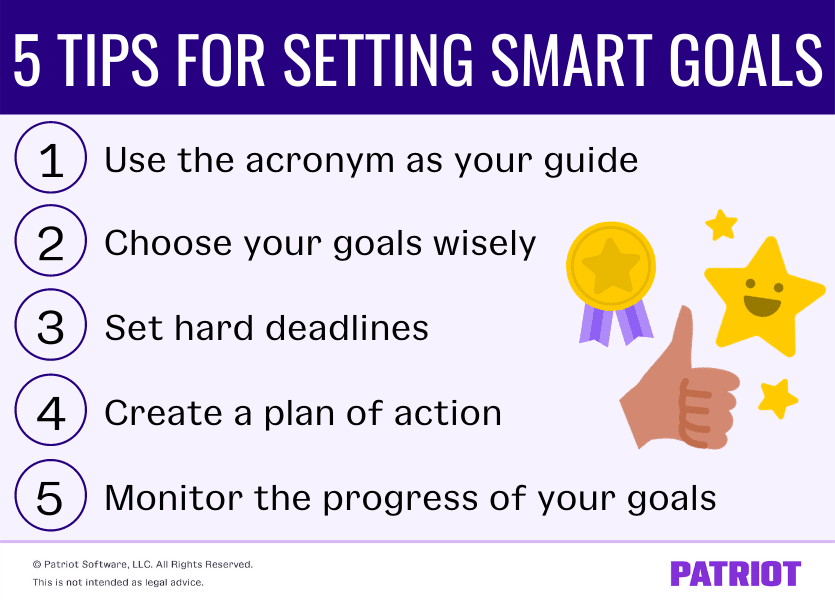When you start a business, you have plenty of goals. Maybe you want to reach a certain customer count by year-end. Or, maybe you want to make a profit by a specific month or year. Whichever goals you strive to achieve, make sure that they’re smart—well, SMART goals, that is. But, what exactly are SMART goals?
What are SMART goals?
SMART goals is a planning process with five pieces of criteria business owners can use to set and evaluate goals. So, what does SMART goals stand for? With the SMART method, you use the following acronym to help establish goals in your business:
- Specific: Be as specific as possible about your goal
- Measurable: Measure whether or not you’re successful in achieving your goal
- Attainable: Include a realistic plan that breaks down your overall goal into smaller action steps
- Relevant: Create goals that make sense compared to your business model, mission statement, market, customer base, and industry
- Time-bound: Limit goals by a specific period of time (e.g., weeks, months, quarters, years)
You can use SMART goal setting for any type of business goal—setting budgets, paying off debt, increasing customer count, improving employee retention … you name it.
Using the SMART formula ensures you don’t miss any details when setting your company’s goals. Not to mention, using the SMART process can help you better outline your goals and provide a clear understanding of what you want to achieve.
Setting SMART goals for business: 5 tips
SMART goals aren’t like any other type of business goals. Instead of being your average (and sometimes vague) goal, SMART goals guide you down a path of actionable steps toward improvement, measurable outcomes, and if done right, success. To help set clear SMART goals for your company and get your goals on the track to success, use these five tips.
1. Use the SMART acronym as your guide
When it comes to setting SMART goals, you can’t be winging the whole process. That’s right—you have to follow the acronym to see a goal become a reality.
When coming up with your SMART goal(s), write everything down, no matter how big or small it is. After you establish and prioritize some goals for your company, break them down using the SMART acronym. During this process, make sure you provide as many details as possible for each letter of the acronym.
Whatever you do, make sure you’re as specific as possible when setting your SMART goals. You can list out your goals by using the SMART acronym, creating a flow chart, making an outline, or using a SMART goals template. Regardless of which method you use, make sure you’ve got your SMART goals in writing and organized so you can refer back to them.
2. Choose your goals wisely
Sometimes, coming up with SMART goals is easier said than done. It can be challenging trying to narrow down exactly which goals you want to set and track (and figuring out which ones are actually worth tracking). So when it comes to establishing your goals, make sure you take your time and choose wisely.
When sitting down and choosing your goals, don’t rush the process. Instead, take some time to list out goals and determine which ones should be your top priority. And, make sure they follow what SMART stands for.
The last thing you want to do is set unrealistic and unattainable goals. So when choosing your goals, make sure that they’re actually attainable and relevant. Don’t set goals that you can’t possibly achieve or that aren’t relevant in the grand scheme of things. Instead, set goals that make you stretch and work hard but are reachable.
On the importance of choosing your goals wisely, Nate Tsang, Founder and CEO of WallStreetZen, said:
The SMART goal process provides business owners a structure on how to attain long-term business goals. Instead of applying this goal-setting process to small, mundane business tasks, try using it on bigger goals such as increasing your business revenue. When you strategize your business goals using the SMART goal process, you break it down into actionable tasks that can help you achieve your bigger business goals. However, to succeed in this goal-setting process, you must have a clear vision of what business goal you want to achieve. If you don’t have a clear goal, it can be hard to be truly successful.
3. Set hard deadlines (and stick to them)
If you want to achieve your goals, you need to set hard deadlines—and stick to them. Otherwise, you’ll just be constantly pushing back your goals and not holding yourself accountable.
When creating your SMART goals, determine a deadline and don’t stray away from it. Keep each goal’s deadline in mind and mark it in as many places as possible to help stay on track. For example, you can track your goals’ deadlines in a document and write them down on a calendar. And, you can set reminders for yourself that the deadline is coming up.
Make sure your deadline is also reasonable (aka don’t make it for the following week). Take time to determine how long it can potentially take to reach your goal. Then, set a reachable deadline (e.g., by the end of the quarter).
4. Create a plan of action
To reach your goals, you have to do a lot more than simply writing them down—you need to take action.
Once you set your SMART goals, come up with a game plan on how you will achieve them. Your plan of action can vary based on the type of goal you’re trying to reach. For example, if you’re trying to increase your customer count by 2,000 people by the end of the quarter, you may include more advertising and social media posting in your plan.
Your goal’s game plan should outline everything you plan on doing to help achieve your goal before its deadline. Include a timeline of when you plan on doing each action to motivate you and keep you on track.
5. Monitor the progress of your goals
Of course, your goals are no good if you don’t monitor your progress along the way. Instead of letting your goals collect dust after you write them down, frequently review and assess your progress.
To measure your goals, check metrics along the way. When your deadline comes to a close, revisit your statistics to see where you stand. Did you reach your goal in time? Were you just shy of reaching your set goal? Review and assess your metrics to see whether or not you reached your goal.
If you did not reach your goal by the deadline, try to determine what held you back. And, determine what you can do to help you reach your goal in the future.
Use your metrics and observations to help build goals for the future. Maybe you were a little too optimistic with your deadline. Or, maybe your goal was unrealistic, and you didn’t realize it until you saw your numbers. Whatever the case may be, use your findings to help set future goals and avoid similar mistakes.

SMART goals example
Now that you know all about SMART goals, let’s see one in action, shall we?
Let’s say you want to increase your website’s traffic because you’ve noticed a dip in recent months. Based on research and previous traffic to your website, you determine you want to increase traffic by 20% before the end of the year. Here’s what your SMART goal may look like written out:
- Specific: To increase website traffic by 20%
- Measurable: Increase annual website traffic from 200,000 to 240,000
- Attainable: We can achieve this if we increase our marketing and advertising efforts
- Relevant: The more website traffic we have, the more people we can reach and convert to paying customers
- Time-bound: Reach the goal by the end of Quarter 4 (end of the year)
Again, you can use SMART goals for objectives big and small. Setting SMART goals can help you better manage and organize your goals and reach more goals in the long run. By using SMART objectives, you can start setting (and hopefully achieving) goals that matter most to your business.
This is not intended as legal advice; for more information, please click here.



